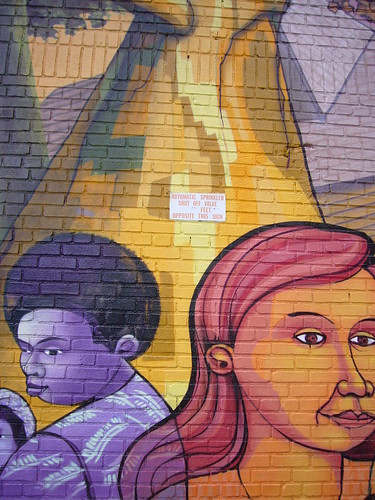As you may remember, photographer Camilo Jose Vergara is one of my favorite photogs, and I recently asked him to autograph my copy of his book American Ruins (first published in 1999).
I also work with Ars Subterranea, and we've screened the work-in-progress film of a couple of our members, Bryan Papciak and Jeff Sias. The film is titled American Ruins, and its website can be found at www.americanruins.com.
One of my friends and collaborators pointed out to me today the first line of the "Book Description" of Drooker's book on Amazon.com: "American Ruins" is the first photography book to document historic ruins throughout the United States." ?!?!?!
It seems like a few people didn't do their research; photographers have been shooting historic ruins in America for many years now. Clarence John Laughlin and his book Haunter of Ruins come immediately to mind, just because now I'm thinking about my favorite photographers. Laughlin is most commonly referred to as a surrealist, but Haunter of Ruins features abandoned and deserted New Orleans buildings, which are pretty darn American. He was most active in the 1940s-60s. I'm sure somebody precedes him as well....
"American Ruins", the name and phrase, is genius and catchy. I understand this. It is not an excuse for it to be the only catchphrase that captures the movement of photographing significant abandoned American buildings.
Mr. Vergara's and Mr. Drooker's works are quite different. Simplistically stated, Vergara's is content driven. His photography is similar to Richard Avedon's (another one of my favorite photogs), in that it is direct and relies on its subject to provide the visual thrills. Drooker's work is romantic, mostly engineered by its use of infrared photography but also by the photos' compositions. I strongly prefer Vergara's style.
I also find it offputting that the main image used on several of American Ruins' (the film) webpages is so similar to Drooker's book cover.
Boo to Merrell, and yes, boo to Drooker as well.

A seldom-viewed Clarence John Laughlin image, interesting particularly in its subject location -
The Head in the Wall [building being demolished, near 2nd and K Streets, N.W., Washington, D.C.]
[Poems of Desolation]
1945
Source: Luminous-lint.com

While I was studying photography as a post-grad student in the early 90's, I traveled to New Orleans a couple of times and visited a photo gallery that had a few Laughlin prints and sold his books. This alone made my visits to New Orleans worthwhile; that's how strongly Laughlin's work affected me.





